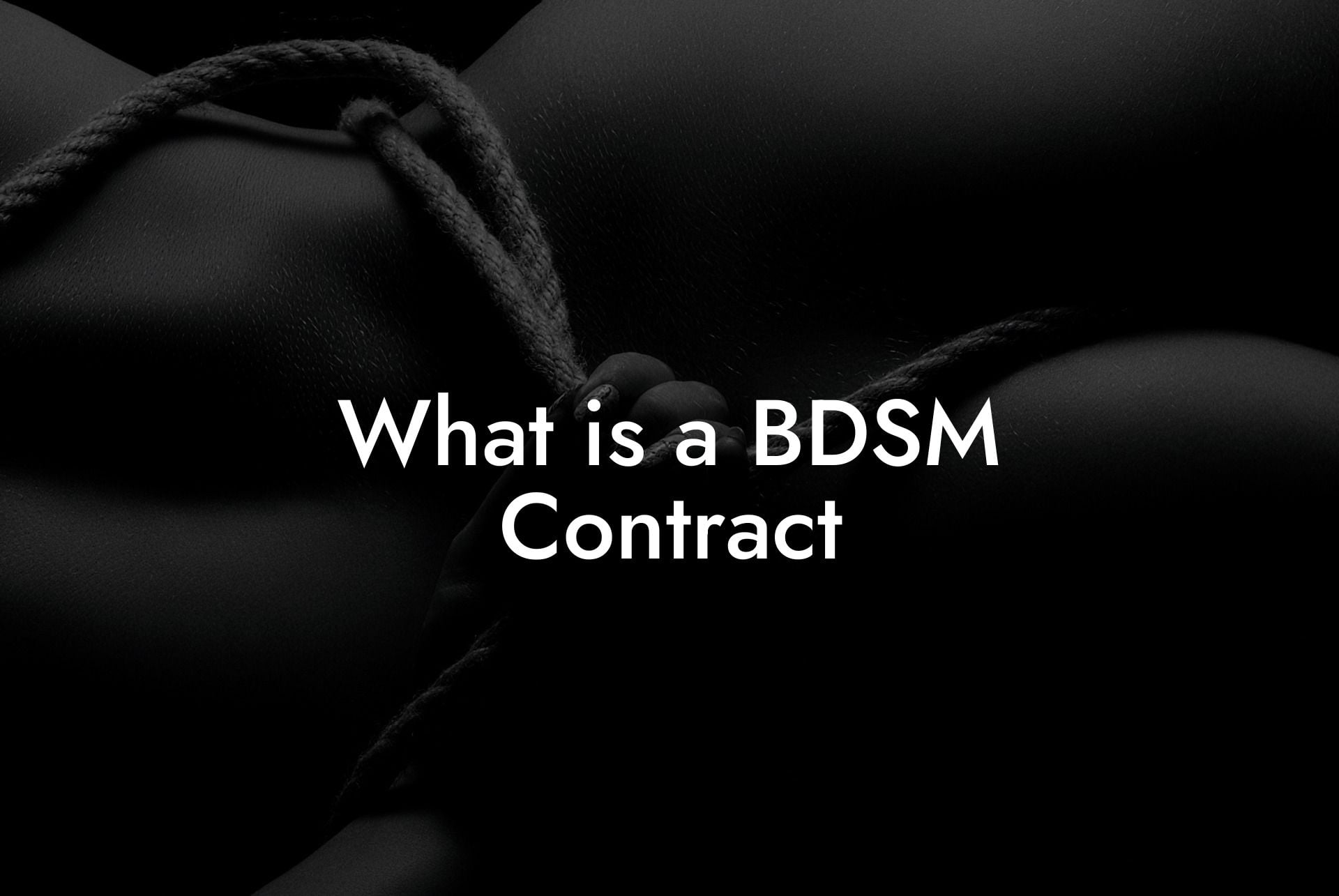What is a BDSM Contract?

A BDSM contract is a mutually agreed-upon document or set of guidelines that outlines the roles, responsibilities, boundaries, and expectations of the parties involved in a BDSM relationship or session. While these contracts are often seen as symbolic and practical tools rather than legally binding documents, they serve as an essential framework for establishing trust, communication, and consent between all participants.
In any BDSM relationship, consent is the cornerstone of trust and respect. It’s more than just saying “yes” or “no”, it’s about openly communicating your desires, limits, and expectations. But trust doesn’t end with a conversation, it’s built through ongoing, clear agreements. That’s where our Dominant & Submissive BDSM Contract Pack comes in. Find out more →
Quick Links to Useful Sections
- History and Context of BDSM Contracts
- The Purpose and Benefits of a BDSM Contract
- Key Components of a BDSM Contract
- 1. Consent and Acknowledgment
- 2. Roles and Responsibilities
- 3. Safe Words and Signals
- 4. Hard Limits and Soft Limits
- 5. Duration and Review
- 6. Confidentiality and Privacy
- 7. Health, Safety, and Aftercare
- 8. Dispute Resolution and Termination
- The Negotiation Process: Crafting Your BDSM Contract
- Legal and Ethical Considerations
- How to Write Your Own BDSM Contract
- Common Misconceptions about BDSM Contracts
- The Role of BDSM Contracts in Enhancing Trust and Communication
- Frequently Asked Questions about BDSM Contracts
- Resources and Further Reading
- Next Steps and Considerations
History and Context of BDSM Contracts
The concept of a BDSM contract emerged from the broader evolution of BDSM culture, where clear communication and negotiated boundaries became vital. In the early days of the BDSM community, much of the trust was built through informal discussions and verbal agreements. As the community grew and gained mainstream attention, many practitioners began formalizing these discussions into written agreements to ensure that all parties were on the same page regarding expectations, roles, and safety protocols.
Today, BDSM contracts are used in various contexts, from one-time sessions between acquaintances to long-term lifestyle arrangements between committed partners. They serve as a communication tool that helps demystify the power dynamics inherent in BDSM, transforming potentially intimidating interactions into structured, consensual, and enjoyable experiences.
The Purpose and Benefits of a BDSM Contract
BDSM contracts are designed to enhance the quality and safety of BDSM play and relationships. The primary purposes and benefits include:
- Establishing Consent: At the core of any BDSM interaction is enthusiastic and informed consent. A BDSM contract clearly states what activities are agreed upon, ensuring that all parties understand and consent to the physical and emotional boundaries set forth.
- Clarifying Roles and Responsibilities: Whether you identify as dominant, submissive, switch, or any other role, a contract can delineate the expectations and responsibilities associated with each role. This clarity helps prevent misunderstandings during play.
- Enhancing Communication: Writing down preferences, limits, and safe words encourages open dialogue. This process fosters trust and enables partners to discuss sensitive topics that might be difficult to address verbally.
- Promoting Safety and Well-Being: By outlining hard limits, soft limits, and safe words, a BDSM contract helps create a safe environment for exploration. It also provides a framework for how to handle unexpected situations or emotional triggers.
- Documenting Agreements: While not legally binding in most jurisdictions, having a written record of what was discussed can prevent disputes or misunderstandings later on.
- Empowering Participants: A BDSM contract empowers each party by providing them with the language and structure needed to negotiate and enforce their boundaries, thereby enhancing overall self-confidence and agency.
Key Components of a BDSM Contract
A well-crafted BDSM contract typically includes several key components that ensure every aspect of the dynamic is addressed. These components may vary based on the participants' needs and the nature of the relationship or session:
1. Consent and Acknowledgment
This section confirms that all parties have given their informed consent to engage in the activities outlined in the contract. It also emphasizes that consent can be revoked at any time.
2. Roles and Responsibilities
Detailing the roles, whether dominant, submissive, or switch, is essential. This section outlines the specific responsibilities and expectations of each role, including behavioral protocols and power dynamics.
3. Safe Words and Signals
Safe words (or safe signals) are vital in any BDSM interaction. This component should clearly define the safe word(s) that can be used to immediately halt or adjust the activity if a participant feels uncomfortable or unsafe.
4. Hard Limits and Soft Limits
Participants should list their hard limits (activities that are absolutely off the table) and soft limits (activities that may be approached with caution). This helps ensure that everyone’s boundaries are respected and that there is room for negotiation where appropriate.
Looking for the best BDSM & Kink OnlyFans content creators? Check out these UNBELIEVABLE OnlyFans Creators:
-
-
-
- Best Slutty Asian Cosplay OnlyFans → 🥵 Shadow Kitsune → View Pictures & Videos
- Best Solo & Dildo Play OnlyFans Creator → 🌹 Lexy , Your Fifty Shades of Fantasy 🌹 → View Pictures & Videos
- Best Filthy Teen Brat & Girlfriend Experience OnlyFans Creator → 💋 Alexa – Your Shy & Wild Girlfriend 💋 → View Pictures & Videos
- Best Slutty Submissive British Blonde OnlyFans Creator → Sofia 🧚 → View Pictures & Videos
- Best Anal, Sexting & Dick Rating OnlyFans Creator → Sofia💕 → View Pictures & Videos
- Best Hot Asian & Latina Mixed OnlyFans Creator → 🍑 Miso Lexii - Half Latina / Half Asian 👅 → View Pictures & Videos
-
-
5. Duration and Review
The contract may specify the duration of the agreement, whether it is session-specific, for a set period, or an ongoing arrangement. It is also common to include clauses for regular review and renegotiation to accommodate evolving needs and comfort levels.
6. Confidentiality and Privacy
Given the personal and sometimes sensitive nature of BDSM practices, confidentiality clauses are often included to protect the privacy of all participants.
7. Health, Safety, and Aftercare
This section covers any specific health considerations, safety protocols, and aftercare plans that are agreed upon. Aftercare is especially critical in BDSM as it helps participants recover emotionally and physically after an intense session.
8. Dispute Resolution and Termination
While the contract is primarily a tool for communication and safety, it is useful to outline how disputes will be handled and under what circumstances the contract can be terminated. This may include guidelines for mediation or simply mutual agreement to end the arrangement.
The Negotiation Process: Crafting Your BDSM Contract
The process of creating a BDSM contract is as important as the document itself. Negotiation should be approached with honesty, openness, and patience. Here are some steps to guide you through the process:
- Open Dialogue: Begin by having a candid conversation about each participant’s desires, limits, and expectations. Discuss what each person hopes to achieve from the dynamic.
- Establishing Boundaries: Clearly articulate your physical, emotional, and psychological boundaries. This includes discussing previous experiences, potential triggers, and any areas of particular sensitivity.
- Defining Roles: Discuss and decide on the roles that each person will assume. Understand that these roles can evolve over time, and flexibility is key.
- Agreeing on Safe Words: Decide on one or more safe words that everyone understands. Some pairs opt for a simple “red” for stop and “yellow” for caution, while others might use more unique words.
- Documenting the Agreement: Once all the details have been discussed, document the agreement. This doesn’t have to be a formal legal document, but it should be clear and detailed enough to serve as a reference.
- Review and Revise: BDSM contracts should not be static documents. Regularly revisit and revise the contract as your relationship or experiences evolve, ensuring that the agreement remains relevant and respectful of everyone’s boundaries.
Legal and Ethical Considerations
It is important to note that BDSM contracts are generally not legally binding. They are created as a framework for communication, negotiation, and mutual understanding, rather than as enforceable legal documents. Here are some legal and ethical points to consider:
- Not Legally Enforceable: In most jurisdictions, BDSM contracts are not recognized as legal contracts. They are tools for personal and interpersonal agreement rather than legal protection.
- Consent is Paramount: The legal foundation of BDSM interactions rests on informed consent. Even with a written contract, ongoing verbal and non-verbal communication is crucial to ensure that consent remains present throughout the interaction.
- Ethical Responsibility: While a BDSM contract may not offer legal recourse, it is ethically binding. Participants have a responsibility to honor the terms agreed upon, and any breach of the contract can harm trust and emotional well-being.
- Privacy Concerns: Given the intimate nature of the agreements, it is essential to consider how the document is stored and shared. Many choose to keep these documents private or use coded language to protect their identities and preferences.
How to Write Your Own BDSM Contract
Creating your own BDSM contract can be a rewarding process that enhances trust and sets clear expectations. Here are some guidelines to help you get started:
- Start with a Template: Numerous online resources offer templates that can be adapted to your specific needs. These templates provide a helpful structure that covers all essential components.
- Personalize the Content: Customize the template to reflect your unique dynamic. Use clear and unambiguous language to describe roles, limits, and expectations.
- Include a Consent Clause: Always include a clause stating that consent is ongoing and that any party can revoke consent at any time.
- Discuss and Revise: Share the draft with your partner(s) and discuss each section thoroughly. Be prepared to revise the document based on feedback and new insights.
- Keep It Accessible: Ensure that all parties have access to the final version of the contract. Consider storing a digital copy in a secure location.
- Regular Updates: Schedule periodic reviews of the contract to ensure that it continues to meet everyone’s needs as your relationship or play evolves.
Common Misconceptions about BDSM Contracts
There are several myths and misconceptions surrounding BDSM contracts that can deter individuals from using them effectively. Here are some of the most common misunderstandings:
- They Are Legal Documents: While some people mistakenly believe that BDSM contracts can be enforced in court, they are generally symbolic and serve as a communication tool rather than legally binding agreements.
- They Limit Spontaneity: Many fear that a written contract will stifle creativity or spontaneity. In reality, a well-crafted contract provides a safe framework that can actually enhance the freedom to explore, knowing that clear boundaries are in place.
- They Are Only for Long-Term Relationships: BDSM contracts can be used for one-off sessions, ongoing play dynamics, or long-term lifestyle arrangements. The flexibility of the contract means it can be adapted to any situation.
- They Replace Verbal Communication: A contract is not a substitute for ongoing dialogue. It should complement, not replace, regular check-ins and negotiations before and after sessions.
The Role of BDSM Contracts in Enhancing Trust and Communication
A BDSM contract is much more than just a document, it’s a tool that fosters open communication and mutual understanding. By clearly outlining the expectations and boundaries of each participant, these contracts help build trust and ensure that all parties feel safe and respected. This clarity not only minimizes the risk of misunderstandings but also encourages partners to explore new dynamics with confidence.
Moreover, the process of negotiating and drafting a contract can serve as a form of relationship-building. It requires participants to be introspective about their desires, limits, and expectations, and it lays a foundation for ongoing, honest conversations about the evolving nature of their relationship or play sessions.
Frequently Asked Questions about BDSM Contracts
Are BDSM contracts legally binding?
In most cases, BDSM contracts are not legally enforceable. They serve as a personal framework for consent and negotiation rather than a legal document. Their primary purpose is to foster communication and establish clear boundaries.
What should be included in a BDSM contract?
A comprehensive BDSM contract typically includes sections on consent, roles and responsibilities, safe words and signals, hard and soft limits, confidentiality, health and safety, and dispute resolution. It should also address the duration of the agreement and provide a framework for regular review and revision.
Looking for the best BDSM & Kink OnlyFans content creators? Check out these UNBELIEVABLE OnlyFans Creators:
-
-
-
- Best Slutty Asian Cosplay OnlyFans → 🥵 Shadow Kitsune → View Pictures & Videos
- Best Solo & Dildo Play OnlyFans Creator → 🌹 Lexy , Your Fifty Shades of Fantasy 🌹 → View Pictures & Videos
- Best Filthy Teen Brat & Girlfriend Experience OnlyFans Creator → 💋 Alexa – Your Shy & Wild Girlfriend 💋 → View Pictures & Videos
- Best Slutty Submissive British Blonde OnlyFans Creator → Sofia 🧚 → View Pictures & Videos
- Best Anal, Sexting & Dick Rating OnlyFans Creator → Sofia💕 → View Pictures & Videos
- Best Hot Asian & Latina Mixed OnlyFans Creator → 🍑 Miso Lexii - Half Latina / Half Asian 👅 → View Pictures & Videos
-
-
Can I modify a BDSM contract after it’s been agreed upon?
Yes, BDSM contracts are meant to be flexible and should be revisited periodically. As relationships and personal boundaries evolve, it’s important to update the contract to reflect any changes in desires or limits.
Do BDSM contracts replace the need for verbal negotiation?
No, a BDSM contract should complement ongoing verbal communication. It provides a written record of agreements but does not replace the essential dialogue that occurs before, during, and after scenes.
Who should be involved in drafting a BDSM contract?
All parties involved in the BDSM dynamic should participate in drafting the contract. This ensures that every voice is heard and that the final agreement accurately reflects the mutual consent and expectations of everyone involved.
Resources and Further Reading
For those interested in learning more about BDSM contracts and how to create one that fits your needs, consider exploring the following resources:
- BDSM Communities and Forums: Join online communities where experienced practitioners share their insights, templates, and advice on creating effective contracts.
- Books and E-Books: Numerous publications explore the philosophy and practical aspects of BDSM, including chapters dedicated to contracts and negotiation techniques.
- Workshops and Classes: Look for local or online workshops that focus on BDSM practices, communication skills, and consent negotiation. These can provide valuable hands-on experience and expert guidance.
- Legal Guides: While BDSM contracts are not typically legally binding, some legal experts have written about the implications of consent and negotiated agreements in kink. These guides can offer additional context.
- Blogs and Websites: Many experienced practitioners maintain blogs that detail their personal experiences with BDSM contracts and provide templates or step-by-step guides.
Next Steps and Considerations
Understanding what a BDSM contract is and how it functions is just the beginning. Whether you are new to BDSM or looking to formalize an existing dynamic, taking the time to discuss, draft, and periodically review a contract can lead to more fulfilling and safe experiences.
Here are a few next steps to consider:
- Start the Conversation: If you haven’t already, open a dialogue with your partner(s) about your interests, boundaries, and what you’d like to see in a contract.
- Explore Templates: Research and review various BDSM contract templates online. Customize one that fits your unique dynamic and ensure it covers all necessary aspects of your interaction.
- Prioritize Communication: Remember that the contract is a living document meant to enhance communication. Regularly check in with your partner(s) about your experiences and adjust the agreement as needed.
- Educate Yourself: Read up on best practices for negotiating consent and setting boundaries. The more informed you are, the more empowered you will feel in your BDSM journey.
- Embrace Flexibility: Recognize that your needs and boundaries might change over time. A successful BDSM contract is one that evolves with you.
By taking these steps, you can ensure that your BDSM experiences are safe, consensual, and mutually satisfying, reinforcing the trust and communication that are the cornerstones of any successful BDSM relationship.
Looking for the best BDSM & Kink OnlyFans content creators? Check out these UNBELIEVABLE OnlyFans Creators:
-
-
-
- Best Slutty Asian Cosplay OnlyFans → 🥵 Shadow Kitsune → View Pictures & Videos
- Best Solo & Dildo Play OnlyFans Creator → 🌹 Lexy , Your Fifty Shades of Fantasy 🌹 → View Pictures & Videos
- Best Filthy Teen Brat & Girlfriend Experience OnlyFans Creator → 💋 Alexa – Your Shy & Wild Girlfriend 💋 → View Pictures & Videos
- Best Slutty Submissive British Blonde OnlyFans Creator → Sofia 🧚 → View Pictures & Videos
- Best Anal, Sexting & Dick Rating OnlyFans Creator → Sofia💕 → View Pictures & Videos
- Best Hot Asian & Latina Mixed OnlyFans Creator → 🍑 Miso Lexii - Half Latina / Half Asian 👅 → View Pictures & Videos
-
-

 Fuck Each Other Not The Planet Unisex
Fuck Each Other Not The Planet Unisex Wear My Kink
Wear My Kink